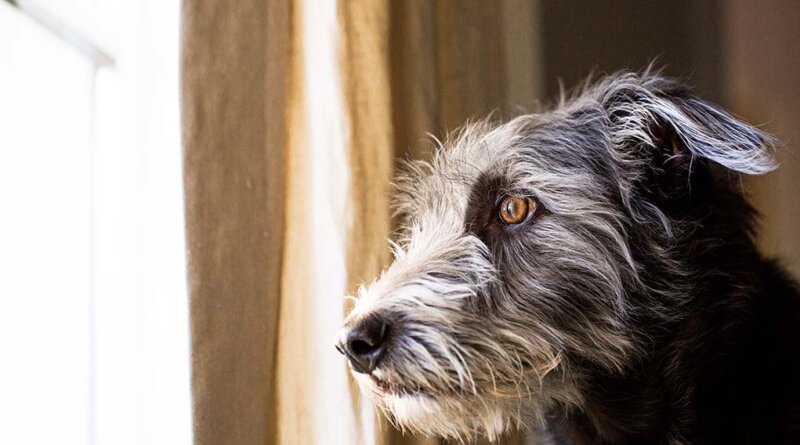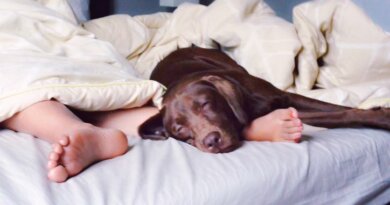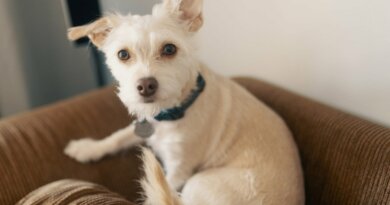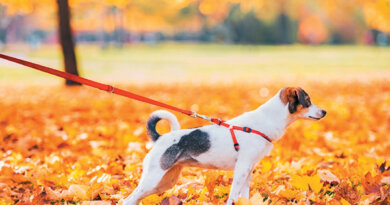Things You Can Do To Ease Separation Anxiety In Your Dog After Covid
As the world struggled with COVID lockdowns, many people were forced to work from home. We were once at work or school throughout the day, now our schedules shifted to staying at home, and our dogs have settled in nicely. As we plan to head back to the office, you may need to ease anxiety in your dog after Covid.
The shift from being left alone for extended periods to consistently surrounded by their family was a welcome change for our furry companions. Dogs have quickly become used to the idea that “normal” now involves their human companions staying home with them 24/7.
But as we shift from our previous lockdown conditions into ones that resemble pre-COVID life, our dogs face suffering considerably. Dogs that were previously able to handle many hours flying solo are now facing anxiety being left alone.
That’s because separation anxiety is starting to spike the less we spend time at home. While many people see a dog’s destructive behavior as vengeful or spiteful, the fact remains that separation anxiety is nothing more than an intense fear or dislike of being alone.
If not handled properly, separation anxiety can increase in intensity. Symptoms that were initially mild or minor can suddenly flair up. These fears can traditionally develop when inadequate socialization or behavioral issues have occurred.
With COVID-19 demanding isolation and limited interactions, there’s been a long period of time that canines have only seen their human family. Here are some ideas to ease anxiety in your dog after Covid.
Identifying Symptoms of Separation Anxiety In Your Dog After Covid
For many pet owners, seeing new or concerning behaviors are often a considerable concern. When a dog becomes clingy (affectionately known as a “Velcro pet”), it can make the transition back to working full-time difficult.
Abrupt changes to the schedule can intensify any symptoms of anxiety, making them worse over time.
Common symptoms include digging, chewing, or destroying the home; urinates or defecates in the home; pacing or panting excessively; trying to escape the house or deliberately hides; barking excessively after departure; or changes in appetite and sleep. Remember, new or sudden symptoms can be the result of a medical condition.
When noticing anxiety in your dog after Covid, it’s important to rule out any ongoing health concerns before treating the dog for anxiety. If your vet gives your dog a medical evaluation and determines nothing is causing these symptoms, it’s likely a behavioral problem.
How to Deal With Separation Anxiety in Your Dog After Covid
Always Remain Consistent with Your Dog
One of the hardest things to happen for a dog is unpredictability. Dogs like knowing what to expect; they are creatures of habit, predicting each behavior based on past events. If you always feed your dog breakfast and take him for a walk before leaving for work, keep this constant.
Set a specific time that they will eat breakfast and go outside and stick with it. It’s important to ease anxiety in your dog after Covid maintains the schedule on your days off, weekends, or times when you’re still working from home.
Having a consistent and regular schedule will help your pup understand that every day, regardless of you being home or not, will have the same routine. Essentially, your absence doesn’t mean that they will lose food, walks, snuggles, or love.
To Ease Anxiety in Your Dog After Covid: Small Increments Over Extended Periods
Whether you adopted a new dog during the lockdown that’s never been left alone or your pup has grown attached to your daily presence, readjusting their schedule needs to be a small, incremental thing. Similar to children, dogs adapt better to change in small doses and timeframes.
Try to encourage positive environments with your dog, particularly if it is exceptionally anxious. A great start in easing anxiety in your dog after Covid is by encouraging your dog to spend time solo in another room while occupying him with a few toys or treats.
Spend time in another room, away from him, for approximately half an hour.
Slowly build to a few hours out of the house while occupying him with treats, toys, or bones he only receives when you’ve left. Make sure to avoid any rawhide treats – they can become lodged in a dog’s throat, posing a choking hazard.
The idea is to provide positive reinforcement to your absence. That is, when you leave, positive things show up (like treats). Eventually, increase the duration of time alone until you’re able to attend work or school without disruptive behavior.
Consider Finding a Pet Sitter or Walker To Help With Anxiety in Your Dog After Covid
As your schedule shifts from being at home all the time to a full-day work week, look at alternative solutions to break up your dog’s day. Consider asking a friend, family member, neighbor, or professional service to walk your dog throughout the day.
The idea is to break up the time the dog is left alone, limiting stress and anxiety. Many dog sitting services offer multiple walks per day, which is perfect for those doing shift work or who have a high-energy dog that needs the activity.
Likewise, many services also offer a “doggy daycare” program. With these arrangements, your dog can be dropped off at the facility for the day, typically around your work schedule, for a day filled with play.
These programs will often host multiple dogs throughout the day, bringing excellent socialization with other dogs. These programs can lessen separation anxiety symptoms due to the constant interaction with dogs and the program owners.
It can also work to burn extra energy throughout the day, tiring out your pup at the same time.
Crate Train Your Dog Might Now Be Necessary
Crate training is an effective method of containing your dog, particularly if they become destructive throughout the day. It provides a safe space away from you, preventing them from injuring themselves or getting into something they shouldn’t.
The proper crate size should allow your dog to stand up, sit down, and lay down comfortably. If a crate is too large, puppies and dogs may learn to soil inside their crate or feel “anxious” with the large space.
If the crate is too small, dogs may develop anxiety about remaining in the same position for extended periods of time (no different than humans become after sitting too long).
Likewise, they can develop nervous habits like chewing the bars or mat if they feel confined.
A crate works to simulate a den in the wild. It’s a space designed to keep the animal relaxed and offers a safe space when the dog is overstimulated. Make sure to leave the crate door open throughout the day and keep minimal items inside.
Do not add food and water to the crate; it’s crucial your pet learns different places for sleeping, eating, and soiling. By keeping food away from the crate, you’ll show your dog this is a “quiet” environment.
Although you can put a blanket inside the crate, if your pup is nervous or suffering from separation anxiety, it may be best to leave everything out of the crate until you can trust their reaction.
Finally, although multiple dogs live inside one home, having their crate is essential. Many dogs can become frustrated being confined to space over time and may react aggressively.
Meet The Dog’s Needs Before Going Back To The Office
If you know your dog will be spending hours alone while you’re at work, it’s essential to provide your dog’s physical and mental conditions to thrive.
That means you need to ensure that your dog has eaten breakfast (or dinner), has gone to the bathroom, and has gotten plenty of physical activity.
Try to take your dog for a long walk before you leave for the morning commute. All dogs should go for walks at least twice a day, but high-energy breeds will need more activity.
If you’re adventurous, try grabbing your rollerblades or your bicycle for the walk. You’ll be able to tackle more areas, which can help tire out your pup faster.
Finally, offer your dog something mentally stimulating in the crate or at the time of leaving for work in the morning. There are kongs that drop treats or kibble, chew toys, and bones to help him unwind.
Stop Encouraging Dramatic Goodbyes or Hellos
As humans, it’s hard not to become emotionally invested in our dogs. After all, they become members of the family effortlessly. A dog suffering from anxiety needs to understand it will be fine with or without your presence.
When we make a big deal out of exits, we reinforce our pet that there is a valid reason for panicking. Likewise, overreacting when they return home also teaches them that your return is something to be overly excited about.
Dogs will internalize this and see it as a negative that you were gone instead of happy you’ve returned home.
To minimize your influence leaving and returning home, don’t react emotionally to your dog’s responses. Take a very calm and relaxed approach to leave.
If your dog is crate trained, call the dog into the crate and close the door. When you return home, dogs are typically hyper and excited to see you, which is a normal reaction.
Instead of feeding into the energy, ignore your dog for the first 15 minutes after you’ve returned home. You can give your dog a simple greeting but let them outside to relieve themselves and continue with your evening.
Complete your day-to-day tasks around the house like dishes and laundry while still engaging your pet.
Knowing When to Get Professional Help
If you’ve been trying to implement these tips without success, your dog may have developed a phobia rather than anxiety. To help with these behaviors, reach out to a dog behavioral expert.
It would help if you ensured that the trainer you select uses positive reinforcement; training will not use punishment.
If you’re dealing with a phobia, punishment can make symptoms worse, especially when it comes to fear. It would be best if you always tried to resolve issues before the issues become a long-term problem quickly.
Should these behaviors be a longer-term issue, don’t panic. Many problem behaviors can be corrected soon with the proper training, assuming they put your dog’s specific needs in a top priority.
It’s always important to remember that dogs are sentient beings with their personality and quirks. While some dogs may not mind being left for hours at a time, other breeds are more sensitive to the removal of the “pack.”
There may be certain dogs that will never be genuinely okay with remaining alone all day by itself, especially when they’ve gotten used to your presence daily. By limiting the length of time alone to reasonable intervals initially, you’re taking the steps needed to set your dog up for success.
Get Started Today
Routines, crates, and physical activity throughout the day are vital steps required to get started.
If your dog has had changes in appetite or sleep, keep an eye on the quantity of food. While a few days of slowed eating isn’t going to harm your dog, a continuous drop in weight can be cause for concern.
Likewise, many of the symptoms associated with separation anxiety can also be attributed to health problems. As such, it may be wise to have your vet evaluate your dog before trying to treat symptoms.
For dogs trying to bolt out the door, always ensure your pet’s microchip is up to date. Keeping your pet inside the home isn’t always the easiest, and occasionally a pet might escape. Should your dog bolt out the door, calmly recall your dog in a happy voice.
Dogs can be receptive to the tone and pitch of the voice (more so than the actual words at times), meaning if the tone sounds abrasive or angry, they’re less inclined to return to you. Offer high-value treats and lots of praise should he return.
Although this may seem like you’re reinforcing the wrong behavior, it’s teaching the dog that should return to you on a recall; good things will happen.
Final Thoughts To Help Ease Anxiety In Dogs After Covid
COVID-19 may have changed the routines with school and work environments but transitioning back to a routine is essential for both you and your dog.
With continuous work and slight changes, you’ll make sure both you and your dog have a happy, healthy, and functioning relationship within the home.
Read Next: How I Help My Dog Deal With Separation Anxiety










Hi, Neat post. There’s a problem together with your site in internet explorer, might check thisK IE still is the market leader and a large component to people will pass over your great writing because of this problem.
Glad to be one of several visitants on this amazing web site : D.
What is Alpha Tonic? Alpha Tonic stands as a natural health supplement designed to comprehensively address men’s overall well-being.
I have recently started a web site, the info you provide on this site has helped me tremendously. Thank you for all of your time & work.